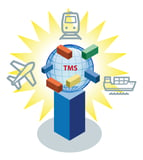What Does Container Management Have to Do With Dinner Parties?
Nick Ostdick - May 17, 2016

Today we begin part 1 of a two-part series on the complexities and importance of container management. Today's article discusses how container management can create complete flexibility and visibility for planned production programs.
You’re throwing a dinner party for six of your dearest friends. You’ve planned a three-course menu, purchased the right amount of ingredients to feed six people, planned enough time to prepare the meal, and set the table with the proper number of place settings. But then you get a call from one of the guests saying they have family in town and they’re bringing two additional diners along to the party. Even though you already had much of the preparation and actual cooking pre-planned, now you have to reassess the amount of food needed to feed everyone, whether you have the ingredients on-hand, and how to best implement additional cooking times and procedures to have the meal on the table at the original specified time.
A challenging proposition, right? And it’s one faced by OEMs, distributors, and supply chain executives across all points of the value chain: how to best manage container strategy to ensure you have the right parts at the right locations at the right time to fulfill customer orders and administer a lean, efficient demand and supply network.
 A big part of this strategy is container management, and much like our home cook who now has to adapt to changing variables in real-time, companies must leverage this same level of agility and flexibility in their container management strategies to ensure sufficient part and production coverages and eliminate waste within the supply stream.
A big part of this strategy is container management, and much like our home cook who now has to adapt to changing variables in real-time, companies must leverage this same level of agility and flexibility in their container management strategies to ensure sufficient part and production coverages and eliminate waste within the supply stream.
Container Management: The 411
In much of today’s global automotive production and supply network, parts are ordered based on forecasted orders that are based on previous customer demand - again, much like our home cook who began preparing the meal based on the anticipated number of guests to attend the party. However, because of increasing complexity across each touch point in the value chain - in part due to expanded production and distribution facilities scattered throughout the world - production programs may change while parts are in transit or because of the realities of actual demand.
As a result, decisions about which containers within a yard should be unloaded - partially or completely - to best provide parts coverage for the overall fluidity of production is a key driver in maintaining an accurate production schedule, avoiding bottlenecks, and reducing the potential for loss or sunk capital and resources. In addition, supply planners and distributors must also weigh decisions about how to best guarantee the right quantity of parts in the warehouse to cover the parameters of production, and how best to facilitate the movement of those parts from containers to the warehouse without creating disruptions in manufacturing or supply.
The lack of insight into which containers to pull from, their current status within the yard, and how best to allocate parts from these containers to a warehouse for production creates problems for planners looking to operate cost-optimal supply and production streams.
The solution is an optimized container management solution that creates complete visibility for the planned production based on new constraints and production variables; allows for real-time glimpses and detailed reporting on supply and inventory levels across all points of the value chain; and provides planners with the capability to evaluate and select specified containers based on actual conditions or production constraints.
Additionally, an optimized container solution allows those within the supply stream to identify potential bottlenecks and respond accordingly to combat these product shortages and secure sufficient part quantities to ensure coverage for planned and altered production parameters.
Container Management: The Benefits
Companies who successfully leverage an optimized container management strategy stand to engender a more lean supply stream and achieve invaluable insight into their overall supply and production processes, which can reveal critical areas of waste and underutilization. While these are more holistic benefits, implementing an optimized container management solution has a number of short-game benefits, including
- Minimizing warehouse inventory: By selecting the right containers to pull from and the right parts to cover planned production programs, companies can significantly reduce parts inventory levels at the warehouse to help increase space, decrease overhead costs, and create more efficient movement of parts from the warehouse to the production facility to decrease lead-times.
- Enhanced Efficiency: Container management not only helps planners make decisions about which containers, when, and where, but also about the products contained within those containers. Space allocation, expiration dates of parts or products, and other metrics are available to planners to help combat production bottlenecks and disruptions, and enhance overall yard or port management efficiency.
- Fewer Special Exceptions: Because container management solutions provide companies with complete visibility as to the contents of a container and their status, fewer special handling situations will arise, thus reducing costs and increasing profitability and productivity. Reducing the number of special transfers or movements to help bolster inventory or supplement production programs - what I call ‘whoops‘ moments - is a core driver in effective production and supply logistics.
To harken back to our poor home cook for a moment: Imagine if he/she had the ability to know in real-time the amount of ingredients left in the pantry; the quantities needed to create larger portions of the meal; the time necessary to complete this; and the best strategy for pulling these ingredients from the pantry to optimize her cooking efficiency. Wouldn’t that be a great value-added proposition for our home cook?
An automotive company dealing with the complexities of global production is no different. This is exactly the kind of transparency, agility, and flexibility an optimized container management strategy can provide, and companies who leverage these solutions can expect invaluable insights into the efficiency and solvency of their supply and production networks.
LATEST POSTS
- Understand Circular Economy in The Manufacturing Industry
- How Can Industry 4.0 IT Integration Be Achieved Smoothly?
- The Significance of Order Sequencing in Discrete Manufacturing
- How to improve your Supply Chain Management: The Power of Control Towers
- Optimizing Human Resource Scheduling in Manufacturing: A Technological Approach



